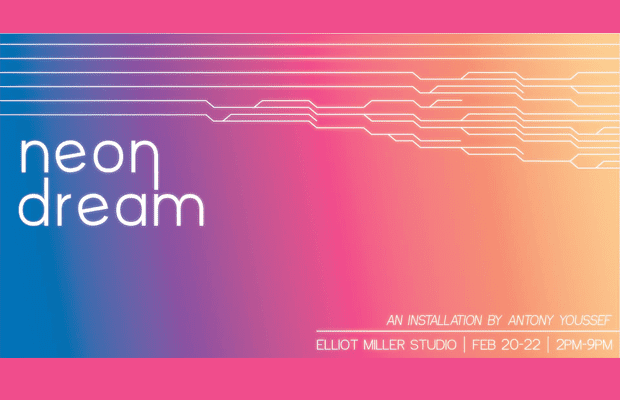A deep, calming fusion of digital chill ambience in parallel with a deep, escapist environment set the tone for me while I walked into Neon Dream, graduate student Antony Youssef’s latest interactive installation.
The experience officially began as I opened the door. It was glaring outside, and entering the room was much like walking into the dark. Closing the door behind me, I was now surrounded by the dark, and to be honest, I lost track of where I was for a moment. However, I eventually found myself to be in a queue, and carefully made my way towards the instalment.
I noticed, in contrast to the bustling sounds of shoes and teenagers chatting about their majors of outside, in this space was distinctly silent. A distinct humming, a deep, resounding square, began to grow on my hearing, and I had thoughts of some of my younger self’s favourite music, much like the opening track of deadmau5’ W:/2016ALBUM. Filling me with a slight sense of nostalgia, I felt a bit more at home in this quiet space; a bit further away from the confines of the city. While the deep bass was the introductory element of the ambience for myself, and most of the ambience had a definite virtual, digital feeling to it all, there was a great variety of sounds, from a quiet, peaceful tune, to a segment that sounded like nature had been emulated on Ableton Live, further giving me this chilling, but comforting, digital experience in the deep of the room.
Entering the installation proper, viewers listen to the range of virtual ambiences while moving about the principle visual element – an array of angular pipes, which seem to emerge from the ground, strobing and flickering in synchronised harmony to the ambience. These pipes are arranged such that they overlap in an organic network-like fashion, and eventually form prism-like transparent walls. Additionally, every pipe has neuron-like connections carved into it, which beautifully illuminate in the deepness of the room, additionally seeming to extend further due to the room’s mirrored walls, giving the installation an Escheresque resemblance.
Viewers walk through this alley of networked neon pipes, and come to a crossroads resembling the shape of a Roman cross, where participants can take in the ambience, walk around the pipes, and disconnect from the otherwise hasty speed of outside. While surely unintentional, the opening of the entrance door can detract from the experience by bringing in unwanted sunlight, so the experience may be more enjoyable during the night.
After experiencing Neon Dream by myself, I spoke to Antony for a bit. Most notably, Antony noted that the arrangement of the pipes, and the ability to immerse oneself in this deep dream was a statement about technology. The dependence of our lives on technology, and even at times the deification of some technologies conveyed through the arrangement of walking paths to that of a cross.
Where I find most agreement with Antony is that he describes the instalment to resemble a church. The quiet ambience coupled with soft, neon piping reminds me of the night services I attended as a child, with the warm lighting of candles illuminating an otherwise darkly, gothic parish.
To many, the parish is a place of comfort and communalism. It is not a difficult leap, then, to propose that technology also provides these feelings, although it was unclear how this provision was viewed by the artist. With virtually zero guidance in the installation, viewers can make their own decision as to whether the installation provides a comfortable atmosphere to them.
When I experienced Neon Dream, I spent a considerable amount of time just taking in what I was looking at; for a total of about twenty minutes I just stood in silence, listening to the ambience and watching the colours change back and forth. Having being introduced to it as being influenced by Vivid or MONA, I had preconceptions that it would be vibrant, energetic, or overtly disturbing. However, instead, Neon Dream surpassed my expectations entirely, and brought to the table a strong message – there is peace in technology, even if not entirely corporeal. By contrasting a softly-lit network of neon neurons with a harmony of calming electronic ambiences, Antony beautifully allows participants to glimpse at unconventional forms of beauty, even if only seen as a wireframe of reality.





